A Review of the Impact of Botched Upper Eyelid Surgery
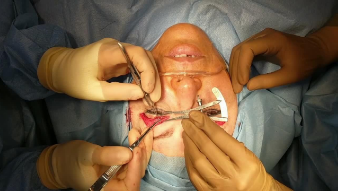
A botched upper eyelid surgery can result in many problems, including asymmetry, drooping, and bulging. If you are considering upper eyelid surgery, ensure that you are a good candidate for the procedure and that your surgeon has the experience and expertise needed to avoid these complications.
REVISION
Blepharoplasty often, blepharoplasty complications arise from patients that do not know the limitations of surgery or use surgery to correct the anatomic issue. Most blepharoplasty surgeons focus on removing the skin, muscles, or fat from the upper eyelids.
They believe in doing this job correctly so there will be assured outcomes. Unfortunately, many eyelid surgery doctors need more training and experience to work effectively.
What Is Revisional Eyelid Surgery?
Revisional eyelid surgery is a type of surgery practiced to correct problems with the appearance of the eyelids. It may do it on the upper, lower, or both eyelids. Revisional surgery can correct eyelid asymmetry, remove excess skin or fatty tissue, and improve the appearance of wrinkles and fine lines. It can also fix problems caused by previous eyelid surgery, such as eyelid malposition or ectropion.
The process is performed under local anesthesia and takes one to two hours. The surgeon will make incisions in the eyelid to remove excess skin or fatty tissue and reposition or tighten the underlying muscles and tissues. The incisions are then carefully closed using fine sutures.
After the surgery, patients may experience swelling, bruising, and discomfort around the eyes. Patients are encouraged to avoid strenuous activities and apply cold compresses to the area. Other medications might be prescribed, and patients must keep track of their progress by attending follow-up appointments with their surgeons.
In conclusion, revision eyelid surgery is performed to correct complications from previous cosmetic eyelid surgery. This type of surgery is usually more complex and challenging than cosmetic eyelid surgery, and it is vital to choose a surgeon who is experienced in this type of surgery.
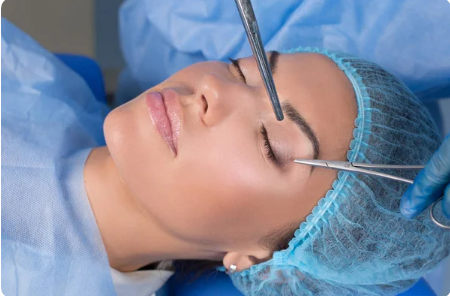
REPAIRING BOTCHED UPPER EYELID SURGERY
If you’ve had upper eyelid surgery and are unhappy with the results, don’t despair. It is possible to repair botched upper eyelid surgery. In this article, we’ll give you a step-by-step guide on improving upper blepharoplasty surgery that has gone wrong.
The initial step is to arrange a consultation with a qualified plastic surgeon. Ask the surgeon about their experience with repairing the upper eyelid skin area. Once you’ve found a surgeon you’re comfortable with, you must schedule a surgery date.
Next, you’ll need to prepare for your surgery. This includes getting plenty of rest and avoiding strenuous activity in the days leading up to your surgery. You’ll also need a ride home after your surgery. On the day of your surgery, you’ll need to follow your surgeon’s instructions regarding fasting and avoiding certain medications.
You’ll typically undergo local anesthesia, so you’ll be awake during the procedure. Your doctor will remove excess skin or fat and close the incisions using fine sutures.
After your surgery, you must follow your surgeon’s post-operative instructions carefully. This may include applying ice packs to the area, using prescribed eye drops, and keeping your head elevated to reduce swelling.
Moreover, you must avoid strenuous activity and wear sunglasses to protect your eyes from the sun. Most patients can return to work and normal activities within 7-10 days, although it may take several weeks for the full results of your surgery to be visible.
Overall, upper eyelid surgery can significantly improve the appearance of your eyes and help you look more youthful and refreshed.
WHAT SHOULD I DO IF I HAVE BAD EYELID SURGERY?
If you’ve had upper eyelid surgery and are unhappy with the results, you may wonder if anything can be done to fix it. Unfortunately, not much can be done to repair botched upper eyelid surgery. Yet, there is good news: you can take a few actions to improve the appearance of your eyelids.
First, you can consult a different surgeon to see if they can offer suggestions. They may be able to provide a revision surgery or suggest another course of treatment. Additionally, you can use camouflage makeup to cover up any imperfections.
This can be a temporary solution, but it might make you feel more confident in your appearance. Finally, you can accept the results of your surgery and focus on the positive aspects of your arrival.
Additionally, revision surgery is a procedure where the surgeon will go back in and make some corrections to the original surgery. It’s important to note that revision surgery is not always successful, and there’s no guarantee that you’ll be happy with the results.
How Long Does It Take For Eyelid Surgery Scars To Go Away?
Most people with eyelid surgery (also called blepharoplasty) experience minimal scarring. Most scars are barely visible and usually fade with time. However, a few factors can affect how long scars heal and fade.
These include the following:
-The type of incision used: Traditional incisions are made on the inside of the eyelid, while more modern incisions are made on the outside. The type of incision used will affect the scar’s visibility and how long it takes to heal.
-The location of the incision: Incisions made closer to the lash line are usually less visible and heal more quickly.
-The thickness of the skin: People with thicker skin often have longer healing times and more visible scars.
-The size of the incision: Smaller incisions generally lead to quicker healing times than larger incisions.
-The skill of the surgeon: A skilled surgeon can minimize scarring and promote faster healing.
-The patient’s age and overall health: Older patients may have slower healing times and may develop more visible scars than younger, healthier patients.
-The presence of underlying medical conditions or medications: Certain medical conditions or medications can affect the body’s ability to heal, which could impact scarring and healing time after eyelid surgery.
-The type of incision technique used: Different methods can affect scarring and healing times. For example, a transconjunctival incision (made inside the lower eyelid) may result in less visible scarring than a traditional external incision.
-Proper aftercare and maintenance: Following the surgeon’s instructions and keeping the incision site clean can help promote faster healing and minimize scarring.
-Smoking and alcohol consumption: These factors can impair the body’s ability to heal and increase the risk of complications, including poor scarring.
-Environmental factors: Exposure to sunlight, pollution, and other environmental factors can also impact healing time and scarring after eyelid surgery. Protecting the incision site from harsh environments can help promote faster healing and minimize scarring.
The time it takes for scars to fade after eyelid surgery varies from person to person. In general, scars take two to six months to fade, but some may take up to a year. In most cases, scars will continue to shrink and eventually become nearly invisible.
During this time, keeping the area clean and dry is crucial to prevent infection. Various treatments, including plastic surgery, are available to help improve the appearance of scars.
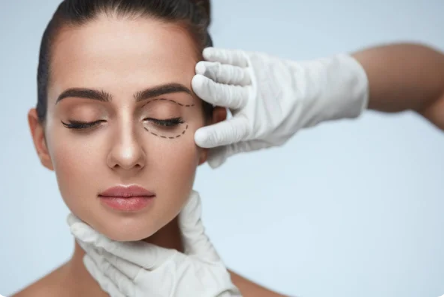
HOW TO FIX BOTCHED LOWER EYELIDS?
If you have had upper eyelid surgery and are not pleased with the results, options are available. The surgeon may occasionally revise the surgery to achieve the desired results. You should, however, consult with your original surgeon before deciding on any corrective surgery.
If unsatisfied with your original surgeon’s work, you may consult another surgeon for a second opinion. Be sure to choose a surgeon experienced in revisional upper eyelid surgery. The surgeon will likely need additional incisions to access and correct the problem areas. The revisional eyelid surgery may be more complex and take longer to heal than the original surgery.
There are a few ways to fix botched lower eyelids. One is to have revision surgery, which involves returning and correcting the original problem. Another option is to use fillers or implants to fill in the space. Finally, you can also do nothing and accept how your eyelids look.
WHAT ARE THE SIGNS OF BAD EYELID SURGERY?
If you’re considering eyelid surgery, it’s essential to research and choose an experienced and reputable surgeon. You should also be aware of any surgery’s potential risks and complications.
One of the most common complications of eyelid surgery is called “ectropion.” This is when the eyelid turns out or away from the eye, which can cause the vision to water constantly. It can also cause the eye to look red and irritated. If you notice these signs after surgery, you should immediately contact your surgeon.
Other complications of eyelid surgery can include infection, dry eyes, and difficulty closing the eye. In rare cases, more severe complications can occur, such as blindness. This is why it’s so important to choose an experienced and reputable surgeon and carefully follow all pre-and post-operative instructions.
Infection can occur after any surgery, including eyelid surgery. Redness, swelling, pain, and pus or discharge are signs of infection. If you suspect a disease, contacting your surgeon right away is essential.
Dry eyes are another common complication of eyelid surgery. This occurs because the eyelid helps distribute tears across the eye, which may not be spread evenly when the eyelid is swollen or distorted. This can cause discomfort, vision problems, and even corneal damage in severe cases.
Difficulty closing the eye is another potential complication of eyelid surgery. This can occur if the eyelids are too tight or the muscles that control eye movement are affected. In some cases, this can become a chronic problem that requires ongoing treatment.
Blindness is a rare but severe complication of eyelid surgery. It can occur if the blood supply to the eye is compromised during the surgery, leading to permanent vision loss.
Although this is very rare, it is a risk that should be carefully considered before surgery.
Other complications of eyelid surgery can include infection, dry eyes, and difficulty closing the eye. In rare cases, more severe complications can occur, such as blindness.
This is why it’s so important to choose an experienced and reputable surgeon and carefully follow all pre-and post-operative instructions.
Infection can occur after any surgery, including eyelid surgery. Redness, swelling, pain, and pus or discharge are signs of infection. If you suspect a disease, contacting your surgeon right away is essential.
Dry eyes are another common complication of eyelid surgery. This occurs because the eyelid helps distribute tears across the eye, which may not be spread evenly when the eyelid is swollen or distorted. This can cause discomfort, vision problems, and even corneal damage in severe cases.
Blindness is a rare but severe complication of eyelid surgery. It can occur if the blood supply to the eye is compromised during the surgery, leading to permanent vision loss. Although this is very rare, it is a risk that should be carefully considered before surgery.
Overall, eyelid surgery can be a highly effective way to address cosmetic and functional eye issues. However, it’s essential to understand the potential risks and complications and choose a qualified surgeon to help minimize these risks as much as possible.
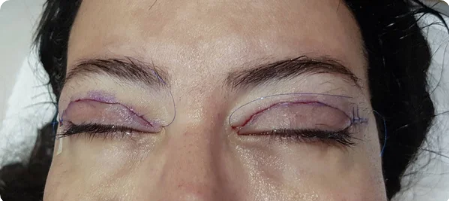
HOW CAN I AVOID A BAD EYELID SURGERY?
Most people don’t think twice about having surgery on their eyelids – but it’s a very delicate procedure. If you’re considering eyelid surgery, research and choose a reputable surgeon.
Here are things you can do to avoid a bad eyelid surgery:
– Research surgeons in your area and read reviews from previous patients
– Request to see before and after photos of the surgeon’s previous patients
– Set up a consultation with the surgeon to discuss your goals and expectations
– Ask the surgeon about their experience and training in eyelid surgery
These recommendations can help ensure you have a positive experience with your eyelid surgery.
Additionally, it is essential to have realistic expectations and a clear understanding of the potential risks and complications associated with this type of surgery. Remember to disclose any medical conditions, allergies, or medications you take to your surgeon.
Also, follow all pre-operative and post-operative instructions provided by your surgeon to minimize and reduce the possibility of complications and ensure a successful recovery.
UNDER EYE-BAGS
If you’re trying to eliminate under-eye bags, try a few things. First, ensure you get enough sleep and drink plenty of water. These two things can help reduce the appearance of under-eye bags.
There are also a few products on the market that claim to help reduce under-eye bags. These include creams, gels, and serums. You can find these products at your local drugstore or beauty retailer.
If you’re still not seeing results, try a cosmetic procedure. One option is laser therapy, which can help to tighten the skin around the under-eye area. Another option is to have fat removed from the under-eye area.
Additionally, home remedies, such as cucumber slices or chilled tea bags, can help to constrict blood vessels and reduce swelling. You can also use an eye cream containing caffeine or retinol to help firm and tighten the skin.
Suppose home remedies and over-the-counter treatments don’t work. In that case, you may need to see a dermatologist or plastic surgeon for more advanced choices for treatment, including surgery or laser therapy.
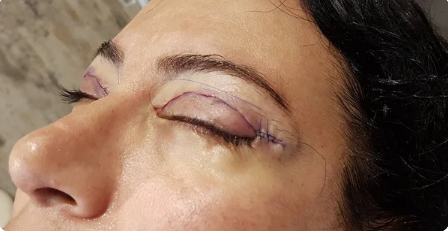
FIXING BOTCHED UPPER EYELID SURGERY
Upper eyelid surgery is a delicate procedure that can often be botched. If you’ve had upper eyelid surgery and are unhappy with the results, a few options are available. In this article, we’ll discuss what you can do to fix botched upper eyelid surgery.
With the right surgeon and treatment plan, you can achieve the upper eyelid surgery results in you’ve been dreaming of. We’ll cover a few options, including revision surgery, fillers, and more. We’ll also discuss what you should look for in a surgeon to ensure you get the best possible results.
Option 1: Revision Surgery
If you’re not satisfied with the results of your upper eyelid skin surgery, revision surgery may be an option. This procedure is typically performed by a skilled and experienced plastic surgeon specializing in eyelid surgery.
Revision eyelid surgery is more complex than the original surgery, as it usually requires additional incisions and more extensive tissue manipulation. However, with the right surgeon, revision surgery can correct the flaws from the previous surgery and provide more satisfactory results.
Option 2: Fillers
Another option to consider is the use of fillers. Injectable fillers can fill in hollows or depressions. It might have been left behind after the initial surgery. This option is less invasive than revision surgery and can improve the appearance of your eyelids.
However, fillers are usually temporary solutions. It should be repeated periodically to maintain the results.
Option 3: Laser Resurfacing
Laser resurfacing is another option for correcting botched eyelid surgery. During this process, a laser removes the damaged or scarred tissue and promotes the growth of new, healthy tissue.
This technique may be particularly effective in treating scars, wrinkles, and fine lines that may have resulted from the previous surgery. However, it may take some time for the results to be noticeable, and several treatments may be required.
Choosing the Right Surgeon
Whatever option you choose, finding a skilled and experienced surgeon specializing in eyelid surgery is crucial. Ask for pictures of their work and read online reviews from previous patients to understand their expertise.
It would help if you also asked about their revision surgery experience and success rates. A good surgeon should be more than willing to address your concerns and help you feel comfortable with your decision.
Botched eyelid surgery can be frustrating and disheartening, but options are available to correct the problem. Whether you choose revision surgery, fillers, laser resurfacing, or a combination of these treatments, finding a skilled surgeon is essential to ensure the best possible outcome.
How Much Does It Cost To Lift An Eyelid?
While the cost of a Blepharoplasty procedure will ultimately depend on the surgeon you choose and the unique details of your case, the average cost of a Blepharoplasty ranges from $2,000 to $4,000. This includes the cost of the surgeon, the anesthesiologist, the facility fee, and other related expenses.
However, remember that this price can vary greatly depending on factors such as your location, the complexity of the surgery, and whether you are having upper eyelid surgery, lower eyelid surgery, or both.
It is also important to note that insurance typically does not cover the cost of cosmetic eyelid surgery, as it is considered an elective procedure. In some cases, if the excess skin on your upper eyelids obstructs your vision, insurance may cover the cost of the upper eyelid surgery as a medical necessity.
In conclusion, whether or not how much it costs to lift an eyelid is a decision that depends on the unique situation and goals of the individual. Lifting the eyelid may be the best option if the goal is to appear more awake. However, keeping the eyelid down may be the better choice if the goal is to avoid appearing surprised or angry.
Why Do People Get Double Eyelid Surgery?
There are many reasons why people may choose to get double eyelid surgery. For some, it is a way to improve the appearance of their eyes and make them look more awake and open. For others, it is a way to correct drooping eyelids interfering with their vision. And for some, it is simply a matter of aesthetics and dissatisfaction with their single eyelids’ appearance.
Overall, Asian eyelid surgery is a safe and effective way to change the shape of the eyelids. Some risks are involved, such as temporary bruising and swelling, but these are typically minor and resolve quickly. The benefits of the surgery include a more youthful appearance and improved self-confidence.
No matter the reason, double eyelid surgery is a popular procedure that can dramatically impact a person’s appearance. If you are considering this type of surgery, consult a qualified surgeon to discuss your goals and expectations.
Making an informed decision and not feeling pressured to undergo surgery to fit in or conform to certain expectations is crucial.
Additionally, it is vital to be aware of the cultural implications and potential risks associated with undergoing a procedure that changes the natural appearance of your features, particularly in the context of vital social pressures to conform to Western beauty standards. Ultimately, the decision to undergo Asian eyelid surgery should be personalized based on your desires and concerns.
THE ORBICULARIS OCULI MUSCLE
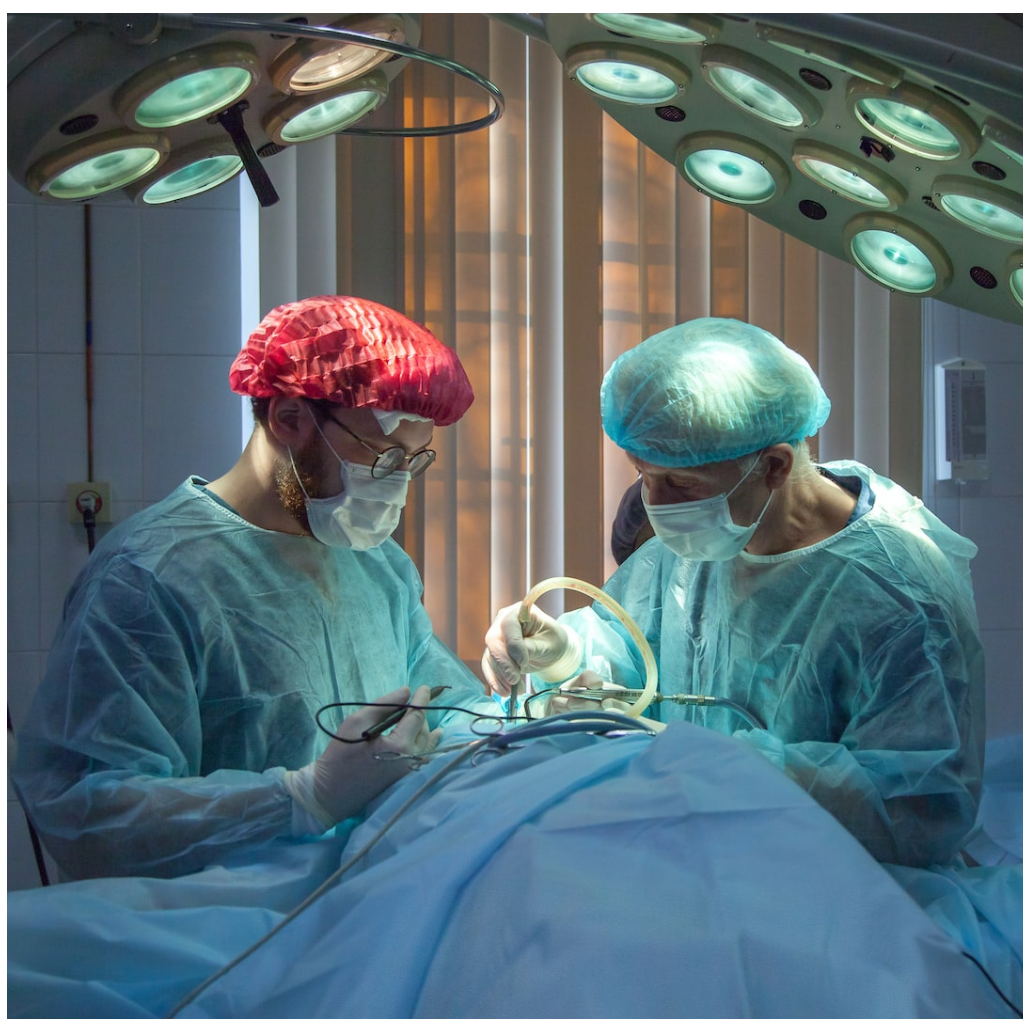
The orbicularis oculi muscle is a circular muscle that surrounds the eye. It is responsible for the blinking reflex and helps close the eye. This muscle is relatively thin and comprises two layers: the superficial and the deep.
The orbicularis oculi muscle innervates by the facial nerve (CN VII). It has plenty of blood supply from the ophthalmic artery. This muscle is one of the key muscles involved in facial expressions. In particular, it helps to create the crow’s feet wrinkles at the outer corners of the eyes.
The orbicularis oculi muscle can be divided into several parts based on its anatomical location and function. The palpebral part is located around the eyelids and is responsible for blinking and keeping the eyes moist. The orbital region is situated around the eye’s bony orbit and helps close the eye tightly. The lacrimal part is located near the tear glands and helps to circulate tears over the eye’s surface.
In addition to its role in facial expressions and eye function, the orbicularis oculi muscle is also used in medical procedures such as blepharoplasty (eyelid surgery) and Botox injections to reduce wrinkles around the eyes. Disorders affecting the orbicularis oculi muscle can lead to blepharospasm (involuntary blinking) and eyelid ptosis (drooping eyelids).
The orbicularis oculi muscle is an essential facial muscle that plays a crucial role in eye function and facial expressions. Its different parts have unique functions and can be used in medical procedures to improve eye appearance and function. However, disorders affecting this muscle can lead to significant problems that may require medical intervention.
BOTCHED LOWER EYELIDS SURGERY
If you are considering lower eyelid surgery or any other type of cosmetic surgery, it is essential to research and choose a reputable surgeon. Unfortunately, not all surgeons are created equal; sometimes, patients have less-than-ideal results. This can be especially true for lower blepharoplasty, a delicate procedure.
You may feel frustrated and disappointed if your lower eyelid surgery has not gone well. You may wonder what went wrong and if you can help fix the problem. The good news is that options are available to help improve the appearance of your lower eyelids.
You may need revision surgery, a procedure performed to correct or improve the outcome of a previous surgery. This can involve removing excess skin, enhancing the shape of the eyelid, or tightening the muscles and tissues around the eye.
Selecting a highly skilled and experienced surgeon to perform your revision surgery is vital. They should be fully knowledgeable about the anatomical structure of the eye and be able to assess your unique situation to determine the best course of action. The typical surgery results for a blepharoplasty lower eyelid are a more youthful and refreshed appearance with a natural look.
In some cases, non-surgical options are also available to help improve the appearance of the lower eyelids. This can include injectable fillers, which can be used to fill in hollow areas or improve the contour of the eyelids. Laser resurfacing is also an option to increase skin texture and minimize wrinkle appearance.
There are many reasons why lower eyelid surgery may be botched. The most common cause is that the surgeon needs more experience. Other reasons include poor planning, bad technique, and a lack of understanding of the anatomy. Discussing your expectations is essential to any concerns with your surgeon.
AESTHETICS OF THE LOWER EYELIDS
The lower eyelids are a crucial part of the face, and their aesthetics are essential to patients. The lower eyelids are prone to developing fine lines and wrinkles and can become droopy with age.
Several procedures can improve the aesthetics of the lower eyelids. Eyelid surgery, or blepharoplasty, is a standard method of removal of excess eyelid skin and fat. This enhances the look of wrinkles and
fine lines.
Injectables, such as botulinum toxin or fillers, can also improve the appearance of the lower eyelids. Muscles can be relaxed with the help of Botulinum toxin that causes wrinkles, while fillers can plump up the skin and smooth out lines.
The Lower Eyelid Rejuvenation Center offers a variety of non-surgical options to help improve the appearance of the lower eyelids. These include laser resurfacing, chemical peels, and micro-needling. These procedures help to stimulate collagen production and the appearance of fine lines and wrinkles.
In some cases, surgical and non-surgical treatments may be recommended to achieve the desired results. During a consultation, a plastic surgeon or dermatologist can evaluate the patient’s concerns and recommend an individualized treatment plan.
Choosing a qualified and experienced provider for any procedure or treatment involving delicate skin around the eyes is essential. Risks and complications, including scarring, infection, and vision changes, can occur. With proper care and attention, however, patients can successfully improve the aesthetics of their lower eyelids and achieve a more youthful, refreshed appearance.
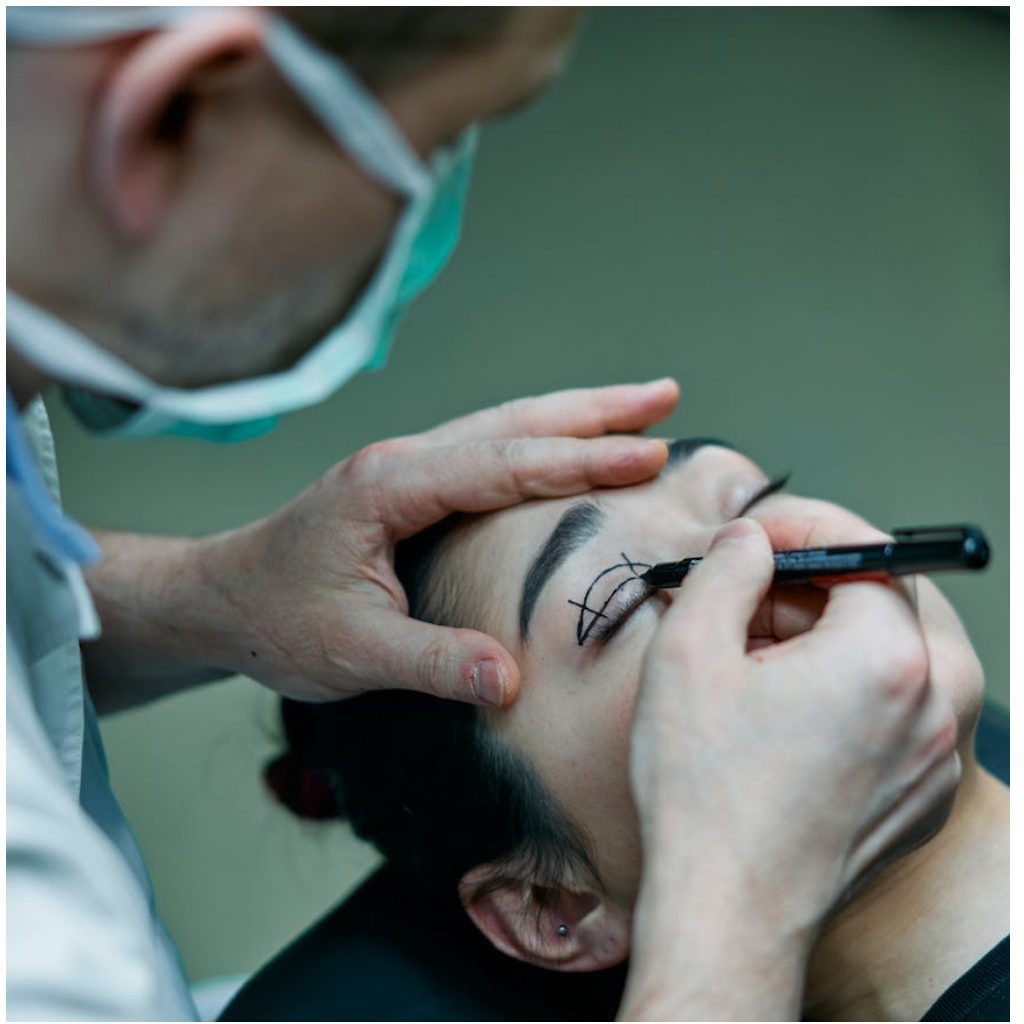
How Do You Fix Lower Eyelid Retraction After Blepharoplasty?
There are a few ways to fix lower eyelid retraction after blepharoplasty. The first thing you can do is inject a little botulinum toxin into the lower eyelid. This will relax the muscles and help to close the gap.
Another option is to place a small piece of tape on the lower eyelid. This will help to hold the eyelid in place and prevent it from retracting. Finally, you can get surgery to tighten the muscles around the eyelid.
There are some ways to fix lower eyelid retraction after blepharoplasty, but each has disadvantages. Surgery is the most invasive and expensive option and is only sometimes successful. Injections can help to relax the muscles causing the retraction, but they must be repeated every few months. Taping the eyelids shut is the least invasive option, but it can be uncomfortable and may not provide a long-term solution.
Another option is to use eye drops or ointments to lubricate the eyes and alleviate dryness or irritation. This can help reduce the symptoms of lower eyelid retraction, but it does not address the underlying cause. They can help you weigh the pros and cons of each option and determine the most effective and safe treatment plan.
CONSULTATION FOR YOUR NEEDS
A consultation with our plastic surgeon will help determine the best treatment course for your case. They can examine you more closely to examine your eyelids and assess the damage. After the consultation, you will better understand what kind of surgery, if any, you may need to fix the problem.
Eyelid surgery is a delicate procedure, and we are committed to helping our patients achieve the best possible results. We will develop a treatment plan tailored to your needs and goals.
Your case will be evaluated during your consultation, and your treatment options will be discussed. They should answer any questions you may have about the procedure and the recovery process.
If you are considering eyelid surgery, we encourage you to schedule a consultation with the American Board of Facial Plastic and Reconstructive Surgery, a board-certified facial plastic surgeon. They will happily help you achieve the beautiful, natural results you deserve.
AN ALTERNATIVE TO FIX BOTCHED EYELIDS
No one likes the look of botched eyelids. They make you look sleepy, angry, and older than you are. But there is an alternative to fixing them with surgery.
Some clinics use a special laser to contour the eyelids and give them a youthful appearance. The treatment is quick, painless, and effective. And best is that it doesn’t involve any surgery.
There are many alternative treatments for fixing botched eyelids. One option is to have cosmetic surgery to correct the problem. Another option is to use special makeup techniques to cover up the issue. Lastly, you can improve the situation with exercises designed specifically for the eyelids.
What Does Botched Mean In Relation To Plastic Surgery
The term “botched” is often used in plastic surgery. It generally refers to a situation where the surgery has not gone as planned, and the patient is left with unsatisfactory results. Sometimes, the term can also refer to a surgery performed without the proper care or attention, resulting in poor outcomes.
Botched plastic surgery can result from various factors, including inexperienced surgeons, inadequate pre-operative planning, or complications during the procedure. It can occur in all types of plastic surgery, such as breast augmentation, facial reconstruction, liposuction, and tummy tucks.
Patients who undergo botched plastic surgery may experience physical and emotional trauma, including scarring, infections, chronic pain, and disfigurement. The recovery process can be lengthy and require additional corrective surgeries.
To avoid botched plastic surgery, patients should carefully research their chosen surgeon, ensure the facility is accredited, and discuss their expectations and desired outcomes with their surgeon. Disclosing any pre-existing medical conditions or medications to the surgeon is also essential.
Overall, the term “botched” should not be taken lightly. It highlights the importance of selecting a qualified plastic surgeon and taking all necessary precautions to ensure a safe and successful outcome.
LOWER EYELID REVISION METHODS TO FIX BOTCHED LOWER EYELIDS
Several methods can be used to revise a botched lower eyelid surgery. The most common practice is to use a skin graft to cover the exposed area. This is usually taken from the upper eyelid skin or forehead. Other methods include using dermal fillers or a fat graft. These methods are less common and are typically only used in cases where the damage is not too extensive.
The decision on which method to use will ultimately be up to the surgeon. They will consider the damage’s severity and the individual’s preferences. In some cases, more than one revision method may be used to achieve the desired results.
In addition to these surgical techniques, non-surgical options such as laser resurfacing or chemical peels may also address skin surface irregularities or discoloration. Patients may also be advised to use specific skincare products or makeup to improve the appearance of the affected area.
With proper care and expertise, botched lower eyelid surgery can be effectively revised to achieve a more natural and aesthetically pleasing appearance. Patients must communicate their concerns and goals with their surgeons during consultation. This will allow the surgeon to develop a personalized treatment plan that best addresses the patient’s needs.
ORBITAL DECOMPRESSION TO FIX BOTCHED LOWER EYELIDS
If you have ever had surgery to improve your lower eyelids, you may be all too familiar with the possible complications that can occur. One of the most common complications is “orbit-syncope,” when the lower eyelid droops or sags after surgery. Correcting this can be a complicated problem and often requires a second surgery.
Orbital decompression is a new surgical technique showing promise in correcting orbit-syncope. This method makes small incisions in the lower eyelid, decompressing the orbital contents. This helps to improve the alignment of the eyelid and can give the eyelid a more natural appearance.
If you have had surgery to fix your lower eyelids and are unhappy with the results, you may ask your surgeon about orbital decompression. This new technique may provide improved outcomes by addressing the underlying issue of orbitasyncope.
Orbital decompression may also be helpful for individuals with bulging eyes or protruding eye sockets due to conditions such as Graves’ disease or other thyroid-related eye conditions.
It is important to note that, like any surgical procedure, there are risks and potential risks and consequences associated with orbital decompression. Discuss these risks with your surgeon and decide the best treatment option.
Overall, orbital decompression is an exciting advancement in surgical techniques for correcting orbitasyncope and improving the appearance of the eye and surrounding area. If you are considering this procedure, qualified research surgeons and have a thorough consultation to determine if it is the right choice.